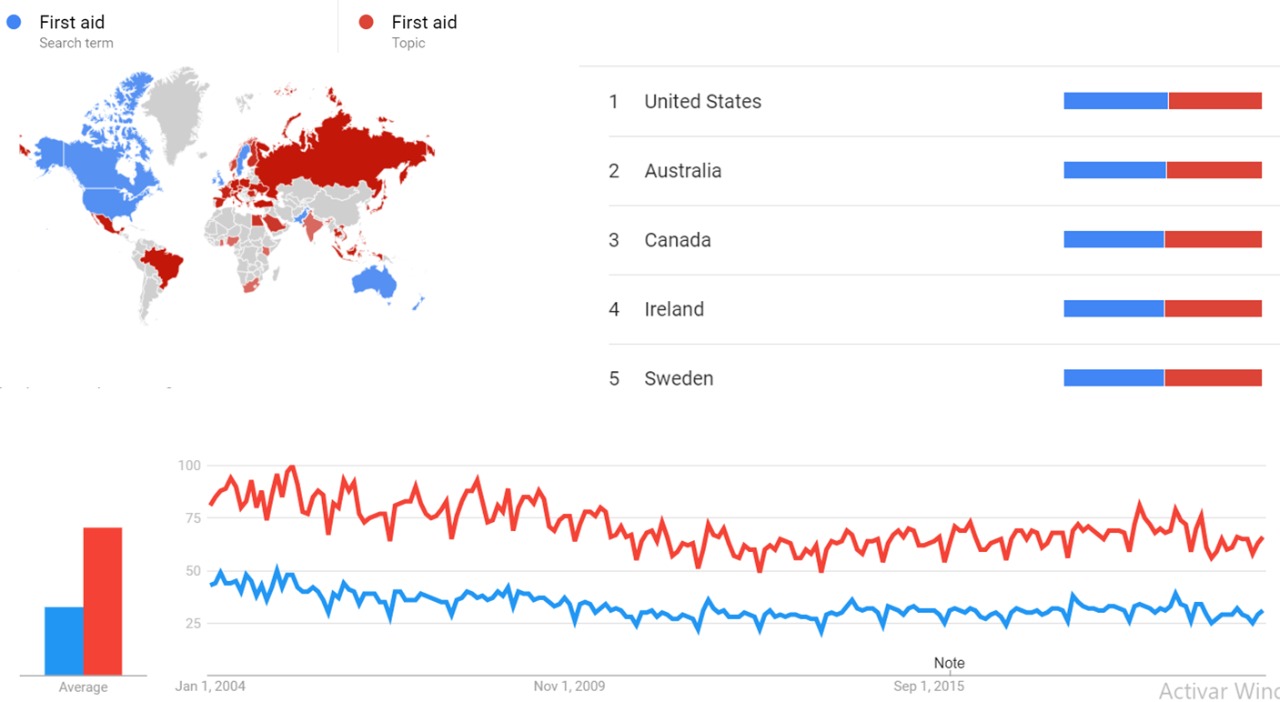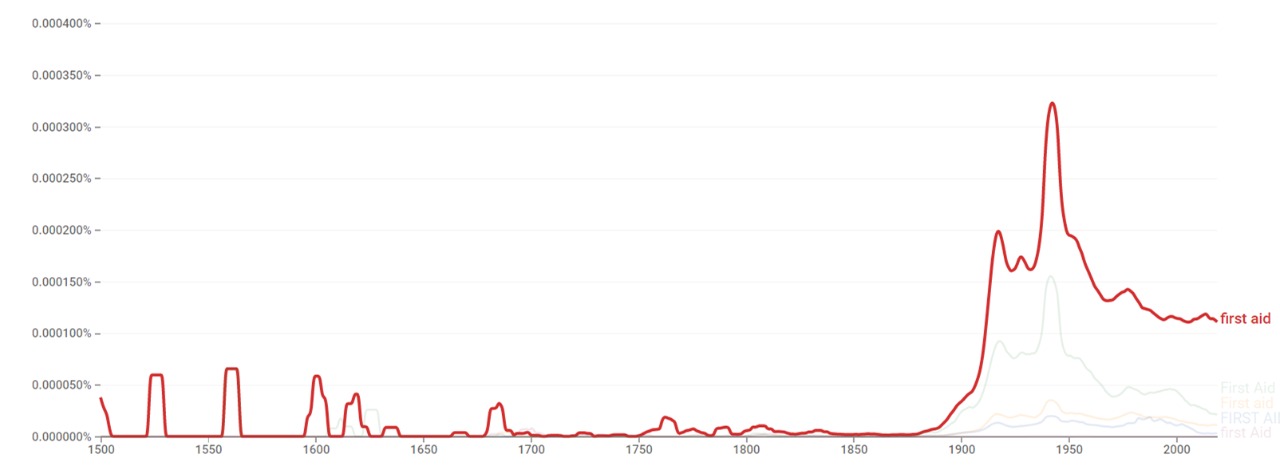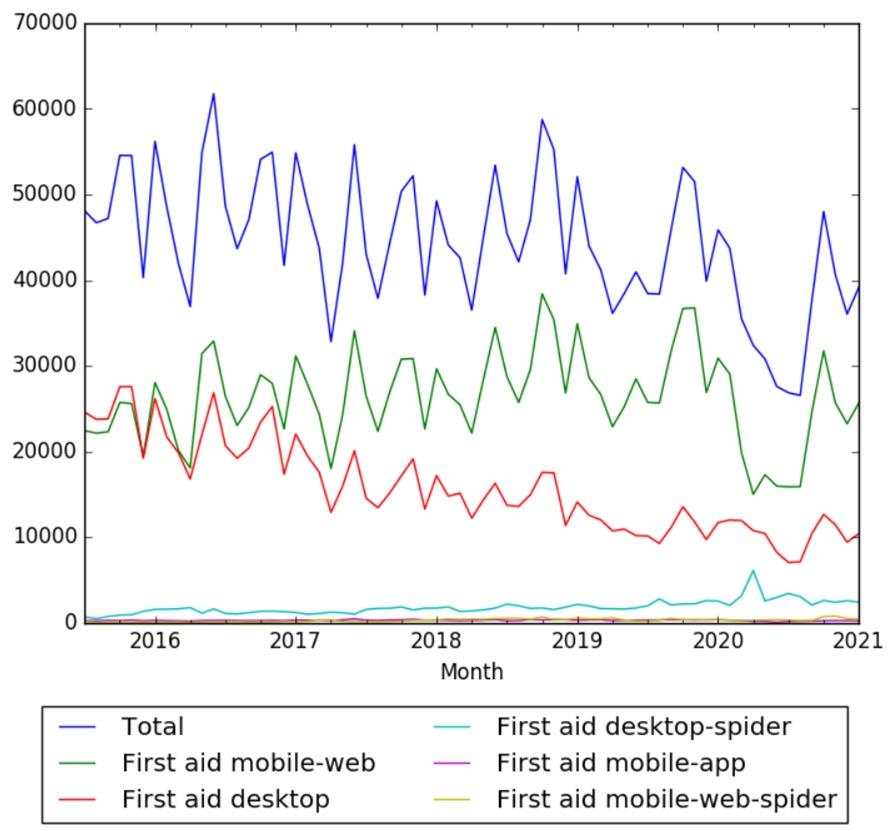Difference between revisions of "Timeline of first aid"
(→Visual data) |
(→Visual data) |
||
| Line 20: | Line 20: | ||
=== Google Trends === | === Google Trends === | ||
| − | The comparative chart below shows {{w|Google Trends}} data for First aid (Search term) and First aid (Topic) from January 2004 to February 2021, when the screenshot was taken. Interest is also ranked by country and displayed on world map. <ref>{{cite web |title=First aid |url=https://trends.google.com/trends/explore?date=all&q=First%20aid,%2Fm%2F0305b |website=Google Trends |access-date=16 February 2021}}</ref> | + | The comparative chart below shows {{w|Google Trends}} data for First aid (Search term) and First aid (Topic), from January 2004 to February 2021, when the screenshot was taken. Interest is also ranked by country and displayed on world map.<ref>{{cite web |title=First aid |url=https://trends.google.com/trends/explore?date=all&q=First%20aid,%2Fm%2F0305b |website=Google Trends |access-date=16 February 2021}}</ref> |
[[File:First aid gt.jpg|thumb|center|800px]] | [[File:First aid gt.jpg|thumb|center|800px]] | ||
| Line 26: | Line 26: | ||
=== Google Ngram Viewer === | === Google Ngram Viewer === | ||
| − | The chart below shows {{w|Google Ngram Viewer}} data for First aid from 1500 to 2019.<ref>{{cite web |title=First aid |url=https://books.google.com/ngrams/graph?content=First+aid&year_start=1500&year_end=2019&corpus=26&smoothing=3&case_insensitive=true |website=books.google.com |access-date=20 February 2021 |language=en}}</ref> | + | The chart below shows {{w|Google Ngram Viewer}} data for First aid, from 1500 to 2019.<ref>{{cite web |title=First aid |url=https://books.google.com/ngrams/graph?content=First+aid&year_start=1500&year_end=2019&corpus=26&smoothing=3&case_insensitive=true |website=books.google.com |access-date=20 February 2021 |language=en}}</ref> |
[[File:First aid ngram.jpeg|thumb|center|800px]] | [[File:First aid ngram.jpeg|thumb|center|800px]] | ||
Revision as of 17:41, 28 February 2021
This is a timeline of first aid, describing significant events in the development of the field. Instrumental and drugs used in first aid kits are described. First aid, as a profession in its own right, has a recent history of only 120 years.
Contents
Big picture
| Time period | Development summary |
|---|---|
| 18th century | Attempts at artificial respiration using bellows inserted into the mouth were often attempted for patients in near drowning episodes.[1] |
| 19th century | In the mid-century, the First International Geneva Convention is held and the Red Cross is created to provide "aid to sick and wounded soldiers in the field."[2] By the end of the 19th century, hundreds of thousands of St John first aid certificates are awarded in four continents.[3] The term "first aid" appears in 1878. In the late century, first aid kits are released by Johnson & Johnson. Along the century, the tracheostomy procedure becomes well established.[1] |
| 20th century | Throughout the century, first aid kits expand to meet new needs. They are customized for homes, schools, travelers and the workplace.[4] In the 1920s, first aid kits are created for unique purposes or carry the names of specific companies and organizations. The 1950s see the introduction of individual items in a first aid kit being packaged in small cardboard boxes.[5] |
| 21th century | While first-aid kits have changed and become more advanced and technical over time, the original intent remains the same.[6] |
Visual data
Google Trends
The comparative chart below shows Google Trends data for First aid (Search term) and First aid (Topic), from January 2004 to February 2021, when the screenshot was taken. Interest is also ranked by country and displayed on world map.[7]
Google Ngram Viewer
The chart below shows Google Ngram Viewer data for First aid, from 1500 to 2019.[8]
Wikipedia Views
The chart below shows pageviews of the English Wikipedia article First aid, on desktop, mobile-web, desktop-spider, mobile-web-spider and mobile app, from July 2015 to January 2021.[9]
Full timeline
| Year | Event type | Details | Location |
|---|---|---|---|
| 3rd century BC | Field development | Homerus of Byzantium documents the story of Alexander the Great performing a tracheotomy with his dagger point to save one of his troops from asphyxiation. The soldier is said to be choking.[1] | |
| 1099 | Field development | The first recorded history of first aid dates to the formation of a religious order of knights trained to administer medical treatment.[10] | |
| 1546 | Field development | Italian physician Antonio Musa Brassavola describes a successful tracheostomy, used to treat a patient with peritonsillar abscess. The patient makes a full recovery, the first recorded occurrence.[1] | Italy |
| 1740 | Field development | The Paris Academy of Sciences officially recommends mouth-to-mouth resuscitation for drowning victims.[11] | France |
| 1767 | Organization | A society for the preservation of life from accidents in water is started in Amsterdam.[12] | Netherlands |
| 1773 | Field development | English physician William Hawes begins publicizing the power of artificial respiration to resuscitate people who superficially appeared to have drowned.[13] | United Kingdom |
| 1788 | Field development | British surgeon Charles Kite, in London, describes the use of a curved narrow metal catheter inserted into the larynx via the nostril in a blind technique, which then could be used to apply ‘bellows’ respiration.[1] | United Kingdom |
| 1792 | Field development | The French Army Surgeon General forms the first official army medical corps. People are trained and equipped for working away from the field hospitals. Their task is to administer first aid on the battlefield and where necessary remove the casualty to the field hospital by carrying them or on carts.[10] | France |
| 1863 | Organization | The International Committee of the Red Cross (ICRC) is formed.[14] | |
| 1860s | Field development | The first Geneva Convention and the International Red Cross come into being to protect and deal with sick and injured soldiers on the battlefield.[10] | |
| 1870 | Field development | German military surgeon Friedrich von Esmarch introduces formalized first aid to the military. Von Esmarch authors a handbook of military surgical technique and institutes training in first aid for civilian and military personnel.[15][16] | Germany |
| 1870 | Organization | The British Red Cross is formed.[10][17] | United Kingdom |
| 1878 | Field development | Two British military officers, Surgeon-Major Peter Shepherd of the Royal Herbert Military Hospital, Woolwich, London, and Colonel Francis Duncan establish the concept of teaching first aid skills to civilians. This radical new enterprise, conducted under the auspices of the newly formed St John Ambulance Association, is considered a natural evolution from the body's philanthropic and ambuance transport work.[3] | |
| 1878 | Field development | The term “first aid” first appears in Britain and is thought to be derived from “first treatment” and “National Aid”.[10] | United Kingdom |
| 1878 | Field development | Surgeon Major Peter Shepherd and Dr Coleman run the first public first aid course in London.[10] | United Kingdom |
| 1881 | Organization | The American Red Cross is founded in Washington, D.C. by pioneering nurse Clara Barton.[18] | United States |
| 1888 | Instrumental | American company Johnson & Johnson begins making the first commercial first aid kits.[19] | United States |
| 1891 | Field development | Dr. Friedrich Maass performs the first equivocally documented chest compression in humans.[11] | |
| 1898 | Instrumental | During the Spanish-American war in 1898, Johnson & Johnson releases small first aid kits that could be carried by soldiers. First aid kits would be used extensively by all armies in the First and Second World Wars.[5] | United States |
| 1898 | Instrumental | A patent by Jerome B. Dillon for a new type of umbilical bandage uses an "antiseptic, absorbent cotton pad" to carry out its function.[20] | United States |
| 1899 | Drug | Bayer introduces aspirin.[21] The drug, is considered an essential for a travel first aid kit.[22] | Germany |
| 1901 | Literature (book) | Johnson & Johnson publishes the Hand Book of First Aid, the first comprehensive, commercially available guide to first aid in the United States. The guide aims at teaching Americans about basic hygiene and emergency care.[4] | United States |
| 1903 | Instrumental | Johnson & Johnson introduces the Household Accident Case, a small kit intended for it—household use.[23] | United States |
| 1903 | Field development | Dr. George Crile reports the first successful use of external chest compressions in human resuscitation.[11] | |
| 1906 | Instrumental | Johnson & Johnson introduces the Autokit. The case's contents—including burn ointment— are meant to help treat injuries during car accidents.[23] | United States |
| 1910 | Policy | All American workplaces with more than three employees are required to have basic medical supplies.[4] | United States |
| 1911 | Field development | The Holger-Nielsen method of cardiopulmonary resuscitation, a manual method of resuscitation popular around the turn of the 20th century, is described in detail in the edition of the Boy Scouts of America Handbook. It would become widely used until the 1950s.[13] | United States |
| 1920 | Instrumental | The Band-Aid, one of the most famous pieces of home medical care, is released as an addition to the first-aid kit.[6][24][25] | |
| 1920 | Instrumental | Johnson & Johnson introduces the Factory Case, meant for use in manufacturing facilities.[23] | United States |
| 1921 | Instrumental | Johnson & Johnson introduces the Travelkit, a pocket-sized first aid kit containing items to treat minor injuries when traveling to areas where medical care is limited.[23] | United States |
| 1925 | Instrumental | Johnson & Johnson introduces the Boy Scout First Aid Kit, created to teach scouts proper first aid techniques.[23] | United States |
| 1927 | Instrumental | Johnson & Johnson introduces the Aerokit, designed for the flight travellers to use on the small one- to two-passenger planes of the day, and including burn emollient, a miniature first aid chart with instructions on how to treat plane-specific injuries in the air and on the ground, and aromatic spirits of ammonia, which could be used to revive a passenger who lost consciousness in the air. The metal case comes in a heavy cloth bag, with a loop attachment, so it could be attached to the aviator’s belt or to the inside wall of the plane.[23] | Unitd States |
| 1933 | Field development | The American Red Cross starts teaching people to save choking persons by slapping them on the back.[26] | United States |
| 1941 | Instrumental | Carlisle Kits are introduced during World War II, after the U.S. military decides to improve the quality of soldiers' first aid supplies and begins packaging them in a wallet-sized, watertight metal container.[23] | United States |
| 1942 | Instrumental | Johnson & Johnson introduces the Vacation First Aid Kit, clocked in at only 5 inches wide and 4 inches long, and designed as an easy-to-pack item for travelers, containing antiseptic cream, a roll of bandages, gauze and a set of first aid instructions.[23] | United States |
| 1945 | Drug | Diphenhydramine, an antihistamine, is introduced.[27] The drug is used to treat allergies, and considered essential in travel first aid kits.[22] | |
| 1954 | Field development | American physician James Elam becomes the first to prove that expired air was sufficient to maintain adequate oxygenation.[11] | United States |
| 1956 | Field development | Austrian physician Peter Safar and James Elam invent mouth-to-mouth resuscitation.[11] | |
| 1957 | Field development | The United States military adopts the mouth-to-mouth resuscitation method to revive unresponsive victims.[11] | United States |
| 1960 | Field development | Cardiopulmonary resuscitation (CPR) is developed. The American Heart Association starts a program to acquaint physicians with close-chest cardiac resuscitation and becomes the forerunner of CPR training for the general public.[11] | United States |
| 1961 | Drug | Ibuprofen is discovered by Stewart Adams and initially marketed as Brufen.[28][29][30] | |
| 1964 | Instrumental | Johnson & Johnson introduces a snake bite first aid kit.[5] It includes a scalpel and plunger, meant to be used to suction snake venom from the skin. It also includes an ammonia inhalant that could help rouse an unconscious bite victim.[23] | United States |
| 1969 | The journal Transactions of the American Broncho-Esophagological Association warns that back slaps are killing people.[26] | United States | |
| 1970 | Policy | The Red Cross changes its policy on back slaps, and publishes a manual reading: "Do not allow anyone to slap you on your back if you are choking and do not try to dislodge an object from another person's throat by this means except as a last desperate effort to save his life."[26] | |
| 1972 | Field development | Leonard Cobb holds the world's first mass citizen training in CPR in Seattle, Washington called Medic 2, helping train over 100,000 people the first two years of the programs.[11] | |
| 1973 | Instrumental | Johnson & Johnson introduces the Marine First Aid Kit, a waterproof and buoyant case, including medications for seasickness and heat exhaustion, as well as an S-shaped plastic tube meant to help revive victims of drowning.[23] | United States |
| 1974 | Field development | American thoracic surgeon Henry Heimlich introduces his new technique later called Heimlich maneuver, a first-aid procedure for dislodging an obstruction from a person's windpipe in which a sudden strong pressure is applied on their abdomen, between the navel and the ribcage.[26] | United States |
| 1980 | Literature (book) | First Aid in Mental Health, by Joy Melville, is first published.[31] | United Kingdom |
| 1989 | Organization | The European Resuscitation Council is established, with aims at providing the standard for resuscitation guidelines and training in Europe and abroad.[32] | |
| 1992 | Literature (book) | The American Red Cross First Aid and Safety Handbook is published by the American Red Cross, and Kathleen A. Handal.[33] | United States |
| 1995 | Field development | The United States Department of Transportation issues a manual for an intermediate level of training called "First Responder".[34] | United States |
| 2000s | Field development | The LUCAS Chest Compression System is designed to help improve outcomes of sudden cardiac arrest victims and improve operations for medical responders.[13] | |
| 2000 | Field development | The Mental Health First Aid Program is developed in Australia by Betty Kitchener and Anthony Jorm.[35] | Australia |
Meta information on the timeline
How the timeline was built
The initial version of the timeline was written by User:Sebastian.
Funding information for this timeline is available.
Feedback and comments
Feedback for the timeline can be provided at the following places:
- FIXME
What the timeline is still missing
Timeline update strategy
See also
External links
References
- ↑ 1.0 1.1 1.2 1.3 1.4 "A Brief History of Endotracheal Intubation". paediatricemergencies.com. Retrieved 6 January 2019.
- ↑ "First Aid: From Witchdoctors & Religious Knights to Modern Doctors". medicinenet.com. Retrieved 18 November 2018.
- ↑ 3.0 3.1 "The earliest days of first aid". doi:10.1136/bmj.309.6970.1718.
- ↑ 4.0 4.1 4.2 "The Birth of the First Aid Kit". jnj.com. Retrieved 4 January 2019.
- ↑ 5.0 5.1 5.2 "The 130-Year History of the First Aid Kit". firstaidshoppe.com. Retrieved 4 January 2019.
- ↑ 6.0 6.1 "History of the First-Aid Kit". providerprepared.com. Retrieved 4 January 2019.
- ↑ "First aid". Google Trends. Retrieved 16 February 2021.
- ↑ "First aid". books.google.com. Retrieved 20 February 2021.
- ↑ "First aid". wikipediaviews.org. Retrieved 22 February 2021.
- ↑ 10.0 10.1 10.2 10.3 10.4 10.5 "History of First Aid". magnifiedts.com. Retrieved 18 November 2018.
- ↑ 11.0 11.1 11.2 11.3 11.4 11.5 11.6 11.7 "History of CPR". heart.org. Retrieved 4 January 2019.
- ↑ The Monthly Review, Or, Literary Journal, Volume 49.
- ↑ 13.0 13.1 13.2 Shanbhag, Madhura; Desai, Brinda; Desai, Vidhi; Bhowmick, Mita. "Cardio Pulmonary Resuscitation – "Retrieving pulses down the years"". International Journal of Research Studies in Science, Engineering and Technology.
- ↑ "Historical background - First Aid for all". ifrc.org. Retrieved 18 November 2018.
- ↑ Kühn, Michael. "Antiquariat" (PDF). antiquariat-banzhaf.de. Retrieved 4 January 2019.
- ↑ "Friedrich von Esmarch". britannica.com. Retrieved 4 January 2019.
- ↑ "The beginning of the Red Cross". redcross.org.uk. Retrieved 4 January 2019.
- ↑ "The History of First Aid in the Army". howstuffworks.com. Retrieved 4 January 2019.
- ↑ "From 1888 to 2013: Celebrating the 125th Birthday of the First Aid Kit". kilmerhouse.com. Retrieved 3 January 2019.
- ↑ Dillon, B. (8 Nov 1898), US Patent #613,761, retrieved 2016-11-29
- ↑ "From a tree, a 'miracle' called aspirin". cnn.com. Retrieved 4 January 2019.
- ↑ 22.0 22.1 "First Aid Kits". emedicinehealth.com. Retrieved 4 January 2019.
- ↑ 23.0 23.1 23.2 23.3 23.4 23.5 23.6 23.7 23.8 23.9 "Safety First: 12 Outside-the-Box First Aid Kits Made by Johnson & Johnson". jnj.com. Retrieved 4 January 2019.
- ↑ "BAND-AID BRAND HERITAGE". band-aid.com. Retrieved 4 January 2019.
- ↑ "THE INVENTION & HISTORY OF BAND-AID BRAND". bandaid.ca. Retrieved 4 January 2019.
- ↑ 26.0 26.1 26.2 26.3 "Historical Essay: The Heimlich Maneuver". abea.net. Retrieved 5 January 2019.
- ↑ History of Allergy (K.-C. Bergmann, J. Ring ed.).
- ↑ Halford, GM; Lordkipanidzé, M; Watson, SP (2012). "50th anniversary of the discovery of ibuprofen: an interview with Dr Stewart Adams.". Platelets. 23 (6): 415–22. PMID 22098129. doi:10.3109/09537104.2011.632032.
- ↑ Halford, GM; Lordkipanidzé, M; Watson, SP. "50th anniversary of the discovery of ibuprofen: an interview with Dr Stewart Adams.". PMID 22098129. doi:10.3109/09537104.2011.632032.
- ↑ "Ibuprofen at 50: The love affair with painkillers". bbc.com. Retrieved 4 January 2019.
- ↑ Melville, Joy. First Aid in Mental Health.
- ↑ "European Resuscitation Council". erc.edu. Retrieved 5 January 2019.
- ↑ "The American Red Cross First Aid and Safety Handbook". Retrieved 3 January 2019.
- ↑ "Emergency Medicine 2: First Responder". s2institute.com. Retrieved 4 January 2019.
- ↑ "Mental Health First Aid: Program grows from humble Canberra beginnings to train people worldwide". abc.net.au. Retrieved 4 January 2019.


